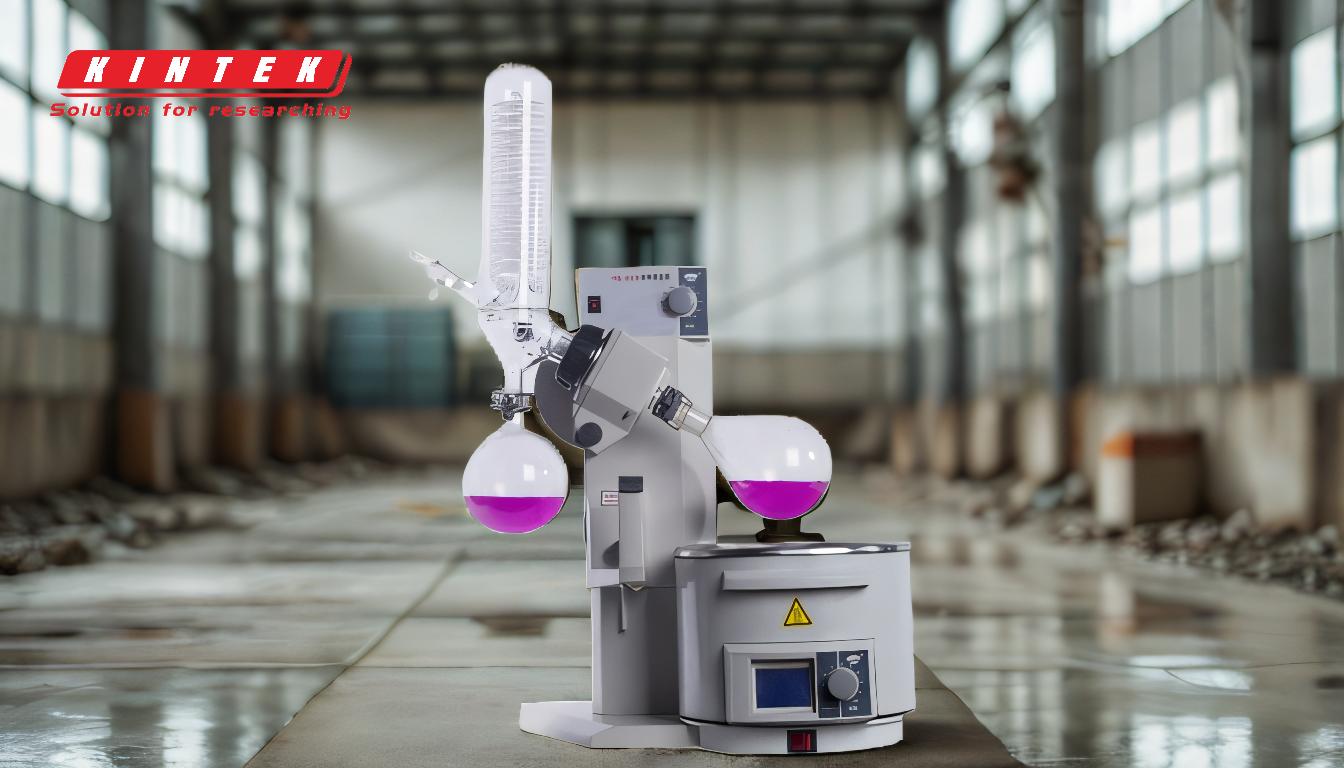The rotary evaporator method is a widely used technique in laboratories and industries for efficient solvent removal, concentration, and purification of samples. It involves rotating a sample flask under reduced pressure while heating it in a water bath, creating a thin film of the sample on the flask's interior. This thin film, combined with controlled temperature and vacuum, accelerates solvent evaporation. The evaporated solvent is then condensed and collected, leaving behind a concentrated or purified sample. This method is particularly valuable for handling volatile solvents and is applied across various fields, including pharmaceuticals, chemistry, and food production.
Key Points Explained:

-
Purpose of the Rotary Evaporator:
- The rotary evaporator is primarily used for processes such as:
- Solvent removal: Efficiently evaporates solvents from samples.
- Concentration: Reduces the volume of a solution to concentrate its components.
- Crystallization: Facilitates the formation of crystals by removing excess solvent.
- Drying: Removes moisture or solvents from solid or liquid samples.
- Separation: Isolates components based on differences in volatility.
- Solvent recovery: Collects and reuses solvents for cost efficiency and environmental sustainability.
- It is especially useful for continuous distillation of large volumes of volatile solvents under reduced pressure.
- The rotary evaporator is primarily used for processes such as:
-
Key Components of a Rotary Evaporator:
-
Distilling Flask:
- Holds the sample and rotates to create a thin film on the flask's interior, enhancing evaporation.
- Typically filled to 50% volume to prevent overflow during rotation.
-
Water Bath:
- Heats the sample to a controlled temperature (usually 30-40°C) to accelerate evaporation.
- Ensures uniform heating of the flask.
-
Condenser:
- Cools the evaporated solvent vapors to recondense them into liquid form.
- Operates at temperatures between -10°C and 0°C using a coolant mixture.
-
Vacuum Pump:
- Reduces pressure inside the system, lowering the solvent's boiling point and enabling evaporation at lower temperatures.
-
Motor Unit:
- Rotates the flask at 150-200 rpm to create the thin film and ensure even heating.
-
Vapor Duct:
- Acts as a vacuum-tight conduit for vapor transport from the flask to the condenser.
-
Condensate-Collecting Flask:
- Collects the re-condensed solvent for recovery or disposal.
-
Mechanical Lift:
- Allows the flask to be raised or lowered from the heating bath for precise control.
-
Bump Guard:
- Prevents sample splashing or bumping during evaporation.
-
Vacuum Release Valve:
- Safely releases vacuum pressure when needed.
-
Distilling Flask:
-
Working Principle:
- The sample is placed in the distilling flask, which is partially submerged in the heated water bath.
- The flask rotates at a controlled speed, creating a thin film of the sample on the interior surface.
- The vacuum pump reduces the pressure inside the system, lowering the solvent's boiling point and promoting evaporation.
- The evaporated solvent travels through the vapor duct to the condenser, where it is cooled and recondensed into liquid form.
- The condensed solvent is collected in the condensate flask, while the concentrated or purified sample remains in the distilling flask.
-
Applications:
-
Chemical Laboratories:
- Used for gentle and efficient solvent removal from organic, inorganic, and polymeric materials.
-
Pharmaceutical Industry:
- Essential for drug formulation, purification, and solvent recovery.
-
Biological Research:
- Used for concentrating biological samples and extracting compounds.
-
Food Industry:
- Applied in flavor extraction, concentration of food products, and solvent recovery.
-
Pilot and Small-Scale Production:
- Ideal for small-scale experiments and production due to its versatility and efficiency.
-
Chemical Laboratories:
-
Advantages:
- Efficiency: Enables rapid solvent removal due to the thin film and reduced pressure.
- Gentle Process: Operates at lower temperatures, minimizing thermal degradation of sensitive samples.
- Versatility: Suitable for a wide range of solvents and sample types.
- Scalability: Can be adapted for both small-scale experiments and larger production processes.
- Cost-Effective: Recovers solvents for reuse, reducing costs and environmental impact.
-
Considerations for Equipment and Consumable Purchasers:
- Capacity: Choose a rotary evaporator with a flask size appropriate for your sample volumes.
- Temperature Range: Ensure the water bath and condenser can achieve the required temperatures for your applications.
- Vacuum Performance: Select a vacuum pump with sufficient capacity for your solvent types and volumes.
- Material Compatibility: Verify that the equipment materials (e.g., glass, seals) are compatible with your solvents and samples.
- Ease of Use: Look for features like digital controls, automatic lifting mechanisms, and safety features (e.g., bump guard, vacuum release valve).
- Maintenance: Consider ease of cleaning and availability of replacement parts (e.g., seals, condensers).
- Energy Efficiency: Opt for models with energy-efficient heating and cooling systems to reduce operational costs.
In summary, the rotary evaporator method is a highly effective and versatile technique for solvent removal and sample concentration. Its precise engineering and controlled conditions make it indispensable in various industries, offering efficiency, scalability, and cost-effectiveness. When purchasing a rotary evaporator, careful consideration of capacity, temperature range, vacuum performance, and material compatibility is essential to meet specific laboratory or production needs.
Summary Table:
| Aspect | Details |
|---|---|
| Purpose | Solvent removal, concentration, crystallization, drying, separation, solvent recovery. |
| Key Components | Distilling flask, water bath, condenser, vacuum pump, motor unit, vapor duct, condensate flask, mechanical lift, bump guard, vacuum release valve. |
| Working Principle | Rotates flask under reduced pressure and heat to evaporate solvents, condense, and collect them. |
| Applications | Chemical labs, pharmaceuticals, biological research, food industry, pilot production. |
| Advantages | Efficiency, gentle process, versatility, scalability, cost-effectiveness. |
| Purchasing Considerations | Capacity, temperature range, vacuum performance, material compatibility, ease of use, maintenance, energy efficiency. |
Discover how a rotary evaporator can optimize your lab processes—contact us today for expert guidance and solutions!









